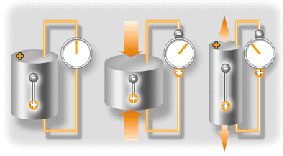The Piezoelectric Effect
Some materials have the ability to produce electricity when subjected to mechanical stress. This is called the piezoelectric effect. This stress can be caused by hitting or twisting the material just enough to deform its crystal lattice without fracturing it. The effect also works in the opposite way, with the material deforming slightly when a small electric current is applied. Piezoelectricity was discovered more than one hundred years ago and has many applications today. It is used in electronic clocks, gas ovens, inkjet printers, and many other appliances. It is also used in scientific instruments that require extremely precise movements, like microscopes. 
History
Pierre Curie and Jacques Curie, two French physicists who were also brothers, first discovered the piezoelectric effect in 1880. Pierre Curie would later share the Nobel prize with his wife, Marie Curie, and Henri Becquerel for their work on radiation. The Curie brothers only discovered that piezoelectric materials can produce electricity, not that electricity can deform them. The next year, Gabriel Lippmann discovered this converse effect. Despite these exciting discoveries, it was not until the early twentieth century that practical devices began to appear. Today, it is known that many materials such as quartz, topaz, cane sugar, Rochelle salt, and bone have this effect.
How the Piezoelectric Effect Works
The piezoelectric effect occurs when the charge balance within a material’s crystal lattice is disturbed. When there is no applied stress on the material, the positive and negative charges are evenly distributed so there is no potential difference. When the lattice is changed slightly, the charge imbalance creates a potential difference, often as high as several thousand volts. However, the current is extremely small and only causes a small electric shock. The converse piezoelectric effect occurs when the electrostatic field that an electrical current creates causes the atoms in the material to move slightly.
Applications
Small piezoelectric crystals can produce enough voltage to create a spark large enough to ignite gas. These igniters are used in many gas-powered appliances like ovens, grillers, room heaters, and hot water heaters. They are even small enough to fit inside lighters, although most lighters still use flint because it costs less and only the more expensive lighters use piezo igniters. While there have been many attempts to generate electricity from the effect, it has proven impractical on a large scale. Piezoelectric crystals are used in electronic clocks and watches to maintain the time and provide the alarm noise. They are also called quartz clocks because the crystal they use is often made from quartz. It has a natural frequency that is ideal for creating the oscillations needed to maintain exact time. Quartz clocks are also used to organize the flow of data in computers. Discs made of piezoelectric material are also used to create thin speakers that fit inside wristwatches. Sonar transducers apply an electrical pulse to a piezoelectric crystal to create a pressure wave, then produce a current when the reflected wave deforms the crystal. The time gap between the two currents is used to work out how far away an object it. Industrial inkjet printers use the converse piezoelectric effect to move ink through the hundreds of nozzles in their print heads. An electric current makes a tiny crystal in each nozzle bend, creating a pressure pulse that forces the ink out. Ink is drawn into the nozzle when the current stops and the crystal relaxes.


Comments - 10 Responses to “The Piezoelectric Effect”
Sorry but comments are closed at this time.